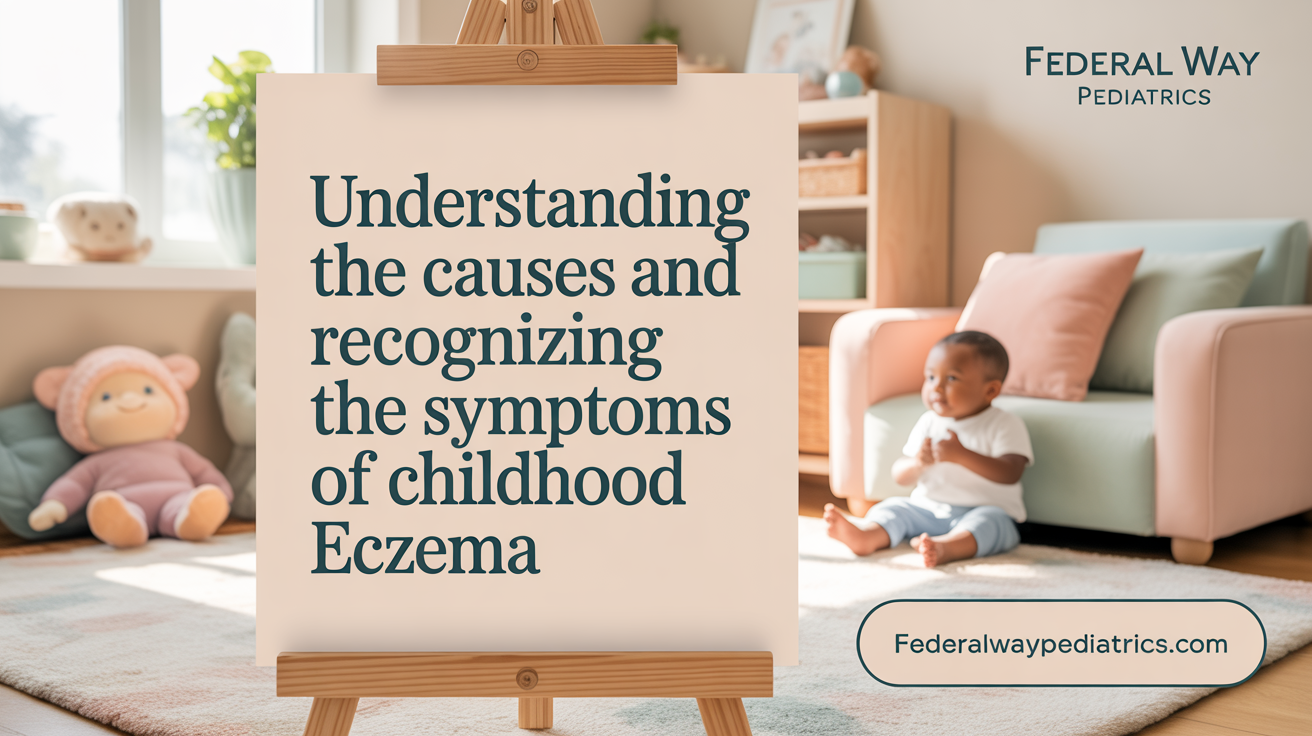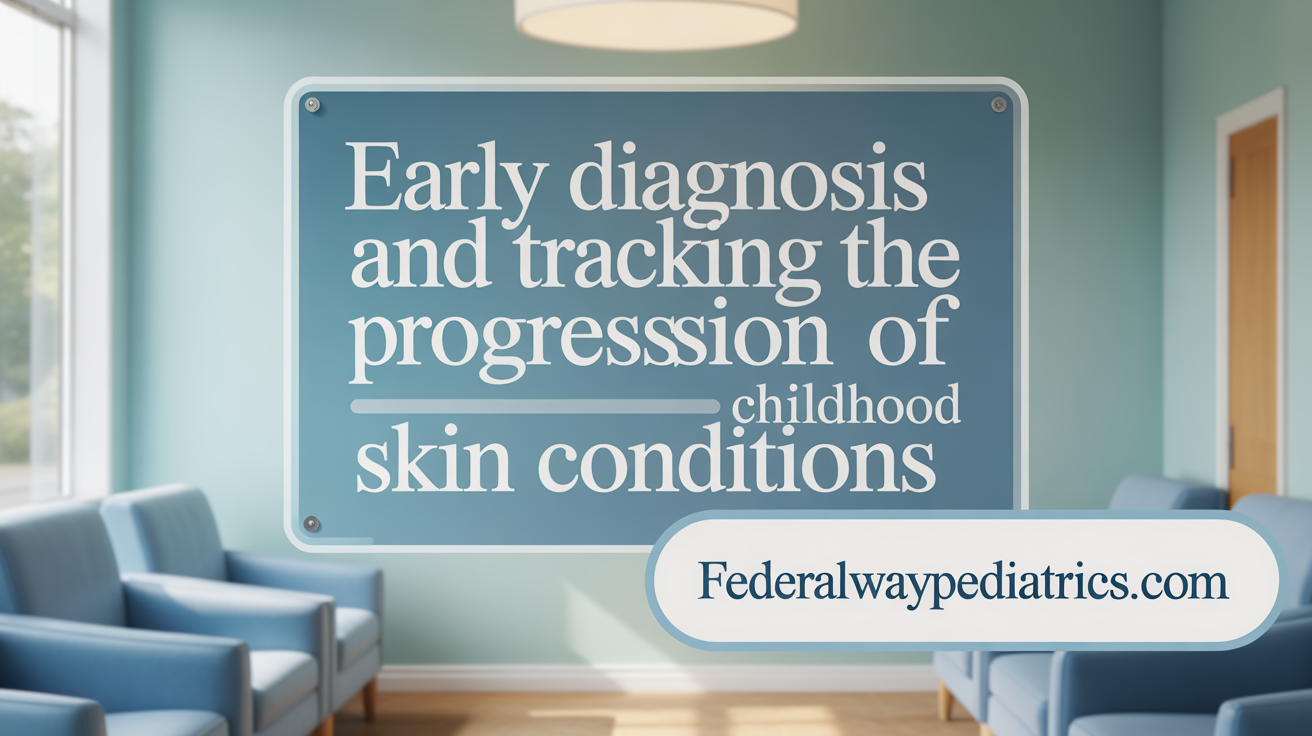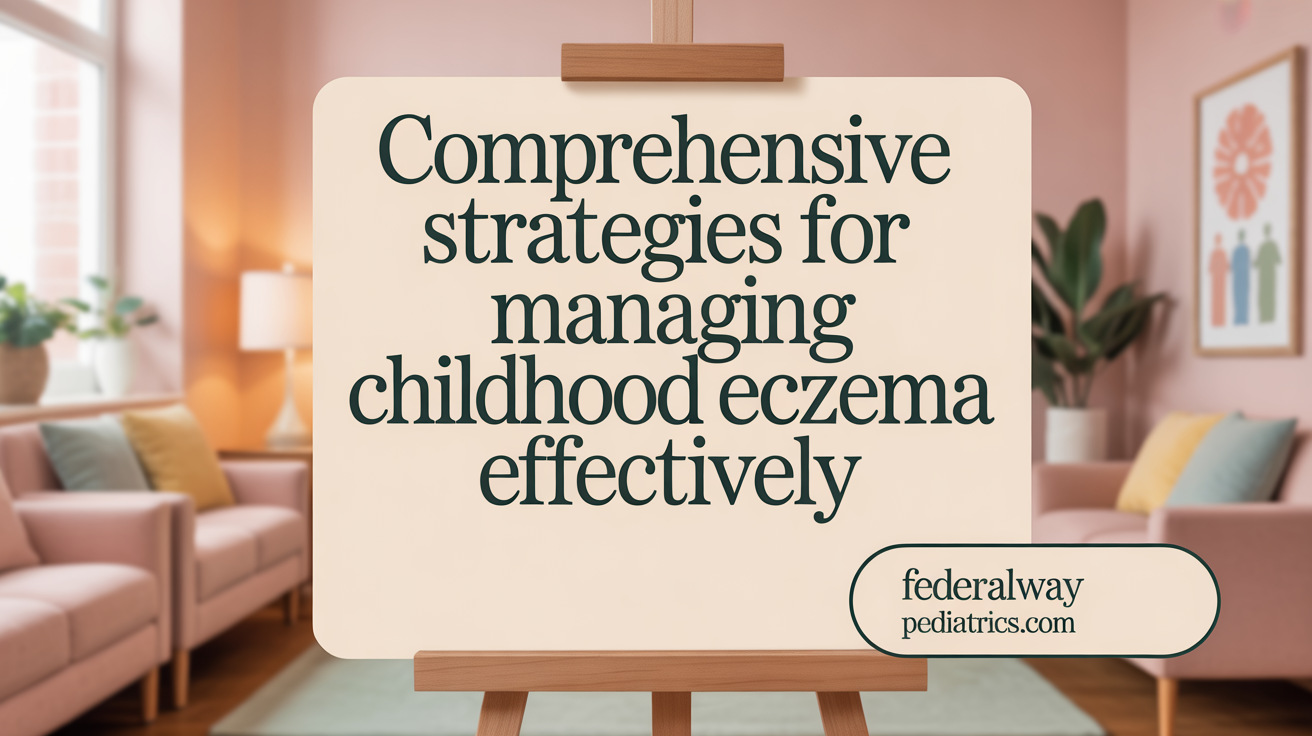Understanding Childhood Eczema
Childhood eczema, also known as atopic dermatitis, is a common chronic skin condition characterized by dry, itchy, inflamed skin in children. Affecting up to 20% of children worldwide, it often begins within the first few months of life and can have a significant impact on the quality of life for both children and their families. This article explores the causes, symptoms, diagnosis, management strategies, treatment options, and prevention techniques to provide a thorough understanding of how to relieve and control childhood eczema effectively.
Causes and Symptoms of Childhood Eczema

What causes eczema in children?
Eczema in children stems from a mix of genetic and environmental factors. A significant genetic component involves a deficiency of filaggrin, a protein essential for maintaining the skin’s barrier. When this protein is lacking, the skin becomes more permeable, leading to water loss and increased sensitivity to irritants.
Environmental triggers also play a crucial role. These include harsh soaps, detergents, exposure to cold and dry air, heat, pollutants, and certain fabrics like wool that can irritate sensitive skin. Allergens such as pollen, pet dander, and dust mites may not directly cause eczema, but they can worsen existing symptoms by triggering immune responses. Children with a family history of eczema, asthma, or hay fever are at higher risk, highlighting the genetic link. Overall, these factors contribute to a compromised skin barrier and overactive immune response, resulting in inflammation, dryness, and intense itchiness.
What are the signs and symptoms of eczema in children?
Children with eczema often exhibit dry, itchy, and inflamed skin. The affected skin may appear red, scaly, thickened, or cracked. In infants, eczema frequently appears on the face, cheeks, and scalp. As children grow, the rash often develops in the creases of elbows and knees, or around the neck, wrists, and ankles.
Symptoms tend to flare periodically, causing noticeable discomfort. The itching is usually severe, especially at night, leading children to scratch the affected areas. Persistent scratching can result in blistering, crusting, or even bleeding, and over time, the skin may become leathery and darker. In some cases, scratches may become infected, further complicating the condition.
Early signs include patches of dry or raw-looking skin, bumps, and intense itching, which can significantly affect a child's well-being and sleep. While severity varies, these physical signs are commonly observed during flare-ups and may persist until appropriate treatment manages the inflammation.
Diagnosing Childhood Eczema and Its Progression

How is childhood eczema diagnosed and how does it progress?
Childhood eczema, mainly atopic dermatitis, is diagnosed primarily through a detailed clinical assessment involving both medical history and physical examination.
Healthcare providers look for characteristic signs such as dry, itchy, and inflamed skin, often appearing in specific patterns like the face, behind the knees, or elbows. A diagnosis requires confirming the presence of itchiness along with at least three other features, including flexural dermatitis, dry skin over the past year, or a personal or family history of atopic conditions such as asthma or allergic rhinitis.
Understanding the typical course of eczema is important. It usually begins early in life, often within the first few months, and may improve with age. However, some children experience persistent or recurrent flare-ups that can extend into adolescence or adulthood.
Standard assessment tools often include questionnaires like the Patient-Oriented Eczema Measure (POEM) and the Children's Dermatology Life Quality Index (CDLQI), which evaluate the impact on daily life and overall severity.
Monitoring involves paying attention to triggers—such as allergens, irritants, or weather changes—and adjusting management strategies accordingly.
Overall, early diagnosis coupled with ongoing management using emollients, topical medications, and trigger avoidance helps control symptoms and reduces the risk of skin infections or other complications. The condition's trajectory varies among individuals, but with proper care, many children see significant improvement over time.
Effective Management and Care Strategies for Childhood Eczema

What are effective management and care strategies for childhood eczema?
Managing childhood eczema involves a comprehensive approach to keep the skin healthy and minimize flare-ups. The foundation of treatment is establishing a regular routine of gentle skin care. Daily baths using lukewarm water and fragrance-free, mild cleansers help prevent skin irritation and support the skin barrier.
A central technique is the 'Soak and Seal' method. This involves bathing in lukewarm water, lightly drying the skin, applying any prescribed medications immediately after bathing, and then sealing in moisture with a moisturizer within three minutes. This approach helps lock in water and reduces dryness, a primary trigger for eczema flare-ups.
Moisturizing plays a crucial role. Thick, high-oil content emollients like petroleum jelly, Aquaphor, or CeraVe should be applied at least twice daily, especially after baths. This helps maintain the skin’s barrier and prevents dryness.
In addition to daily skincare, specific therapies can be employed. Bleach baths, diluted to a concentration similar to chlorinated pools, can reduce bacteria and inflammation, lowering infection risk. Wet wrap therapy — applying damp bandages over medicated skin — can soothe inflamed, severely irritated skin.
For more severe cases, treatments include topical steroids, calcineurin inhibitors, and newer options such as biologics like Dupixent (approved for children age 6 and older) or JAK inhibitors. The selection depends on individual severity and should always be guided by healthcare professionals.
Protective clothing such as soft, cotton fabrics helps avoid irritants. Keeping children’s nails trimmed and using cotton gloves at night can prevent scratching during sleep, which worsens eczema and causes skin infections.
Importantly, avoiding known triggers such as harsh soaps, fragrances, dust, pet dander, certain foods, and extreme temperatures is vital. Regular monitoring, patient education, and adherence to treatment plans significantly improve quality of life and reduce the intensity and frequency of flare-ups.
Treatment Options and Relief Strategies for Childhood Eczema

What treatment options and relief strategies are available for eczema in children?
Managing childhood eczema involves a combination of skincare routines, medications, and lifestyle adjustments to control symptoms and prevent flare-ups.
One foundational approach is the regular use of emollients and moisturizers, which help maintain the skin’s barrier and keep it hydrated. Thick creams or ointments like Vaseline, Aquaphor, or CeraVe are recommended to be applied at least twice daily and right after bathing to lock in moisture.
For inflammation and itching during flare-ups, topical corticosteroids are the most effective treatment. These should be used under medical supervision, with careful attention to application duration and frequency. Alternatives to steroids, such as calcineurin inhibitors like tacrolimus or pimecrolimus, are suitable for sensitive areas like the face and eyelids.
In more severe cases, healthcare providers might prescribe systemic medications. Biologic therapies such as dupilumab, FDA-approved for children aged 6 and older with moderate to severe eczema that doesn’t respond to topical treatments, are emerging options. New avenues like JAK inhibitors are also being studied.
Additional relief methods include bleach baths, which can reduce bacteria and prevent skin infections when used periodically, and wet wrap therapy, which involves applying medicated dressings that hydrate and soothe inflamed skin.
Managing itch is crucial, so antihistamines may be recommended, especially to improve sleep during flare-ups. If infections occur, antibiotics or antivirals are prescribed to combat bacterial or viral skin infections.
Proper skin hygiene is vital. Gentle bathing with lukewarm water and fragrance-free cleansers helps restore the skin's barrier. Avoiding irritants—such as harsh soaps, fragrances, and rough fabrics—is important in minimizing triggers.
Stress management and behavioral strategies, like keeping nails short, wearing soft clothing, and employing distraction techniques, help reduce scratching. Creating a supportive environment and educating children about their eczema empower them to participate actively in their care.
In summary, a comprehensive eczema management plan combines diligent skincare, appropriate medication, trigger avoidance, and lifestyle adaptations, all tailored to the child’s individual needs, to improve quality of life and reduce flare-ups.
Tips for Soothing and Alleviating Eczema Symptoms in Children
How important is moisturizing and when should it be applied?
Keeping the skin well-moisturized is one of the most effective ways to manage eczema in children. Applying a generous layer of fragrance-free ointments or creams, such as petroleum jelly or Aquaphor, at least twice daily helps to restore the skin barrier and lock in moisture. Immediately after bathing—ideally within three minutes—is the optimal time to apply moisturizer, as the skin is damp and more receptive to hydration.
What gentle cleansing techniques can help?
Gentle skin care is fundamental. Using lukewarm water and mild, fragrance-free cleansers prevents further irritation. Harsh soaps, scented detergents, and fabric softeners should be avoided because they can strip natural oils and worsen dryness. Short bathing sessions, around 3 to 5 minutes, are enough to cleanse without drying out the skin.
Which bath additives are soothing for eczema?
Bath time can be made more soothing with additions like colloidal oatmeal, salt, baking soda, or specialized bath salts. These ingredients can calm inflamed skin and reduce itching. In some cases, diluted bleach baths—under medical supervision—are used to decrease bacteria on the skin and prevent infections, especially during severe flare-ups.
How can scratching be prevented?
Preventing scratching is vital to avoid skin damage and infections. Keep children’s nails short, and consider using cotton gloves or socks over their hands during sleep. Distraction techniques, such as engaging in toys or activities, and applying barrier creams can help reduce the impulse to scratch. Sometimes, wet wrap therapy is recommended for severe cases, providing a soothing barrier over the skin.
What clothing and soothing strategies support skin health?
Dressing children in soft, breathable fabrics like 100% cotton helps minimize irritation. Avoid wool or synthetic fibers that can aggravate sensitive skin. To soothe inflamed skin during flare-ups, strategies like wet wrap therapy, regular moisturizing, and managing environmental triggers are beneficial. Creating a calm environment, maintaining consistent routines, and managing stress can also contribute to reducing eczema severity.
This combination of proper hydration, gentle cleansing, protective clothing, and behavioral strategies can significantly ease the discomfort of eczema in children. Consulting with healthcare providers for personalized treatments—including medications such as topical steroids or biologics—may further improve symptoms and quality of life.
Preventing Eczema Flare-Ups in Children

How can parents and caregivers prevent eczema flare-ups in children?
Children with eczema often experience flare-ups that can be triggered by various environmental, skin, and behavioral factors. To minimize these episodes, it is essential for parents and caregivers to take proactive measures.
First, identifying and avoiding common triggers is crucial. These include harsh soaps, synthetic fabrics, fragrances, and environmental allergens like pollen and pet dander. Choosing gentle, fragrance-free skin cleansers and using protective barriers can help reduce irritation.
Maintaining skin hydration is vital. Applying thick, fragrance-free emollients immediately after baths creates a protective 'seal' that retains moisture and strengthens the skin barrier. This routine is especially effective when combined with daily moisturizing at least twice a day.
Bathing practices also play a significant role in preventing flare-ups. Use lukewarm water and limit baths to 10-15 minutes to prevent skin dryness. Opt for mild, fragrance-free cleansers and avoid scrubbing, which can damage sensitive skin.
Environmental and clothing considerations are equally important. Dressing children in soft, breathable fabrics like 100% cotton reduces irritation. During dry or winter months, using a humidifier helps add moisture to the environment, preventing skin from drying out.
Effective nail care is another key aspect. Keeping nails short and smooth minimizes skin damage from scratching, which can lead to infections. Some caregivers also use cotton gloves at night to prevent children from scratching during sleep.
Managing stress and encouraging relaxation can lessen the tendency to scratch, thus reducing flare-ups. Techniques such as distraction, guided imagery, and maintaining a regular sleep routine contribute positively.
In summary, consistent skin care, trigger avoidance, and environmental adjustments are essential strategies. Promptly seeking medical advice during flare-ups or signs of infection ensures proper treatment and overall better management of childhood eczema.
Evidence-Based Guidelines for Managing Atopic Eczema in Children
Is there a holistic approach to treat childhood eczema?
Yes, managing childhood eczema effectively requires a comprehensive, holistic approach. This includes consistent daily skin care routines focusing on skin hydration and barrier repair, such as moisturizing generously with emollients like petroleum jelly or other ointments immediately after bathing. Gentle bathing practices—using lukewarm water and fragrance-free cleansers—are fundamental in reducing skin irritation. Recognizing trigger exposure to irritants, allergens, and environmental factors is vital. Addressing associated issues like infections and mental health concerns through appropriate treatment and support further enhances management.
How is stepped therapy tailored according to eczema severity?
The treatment strategy depends on how severe the eczema is. For mild cases, over-the-counter remedies like gentle cleansers and moisturizing creams may suffice. Moderate to severe eczema often requires prescription treatments—such as topical corticosteroids or calcineurin inhibitors—used under medical supervision. Severe cases might benefit from advanced therapies like phototherapy, immunosuppressants, or biologics like dupilumab. In particularly intense episodes, wet wrap therapy and bleach baths are valuable adjuncts. Treatment intensity and medication potency are adjusted based on the child's response and lesion severity, enabling personalized care.
Why is caregiver education and home management planning important?
Educating caregivers is crucial for effective eczema control. It involves teaching them how to properly apply emollients and medications, recognize early signs of flare-ups, and avoid common trigger factors such as harsh soaps, fragrances, and irritant fabrics. Developing a tailored home management plan helps families implement consistent routines, like daily bathing and moisturizing, managing the environment to reduce allergens, and avoiding scratching by keeping nails short or using cotton gloves at night. These strategies help prevent worsening symptoms and reduce flare frequency, empowering families to manage eczema confidently.
What roles do infection control and psychological support play?
Skin infections are common among children with eczema, often bacterial or viral, which can worsen inflammation and itchiness. Prompt treatment with antibiotics or antivirals when infection signs appear is essential. Addressing the psychological impact of eczema—such as sleep disturbances, irritability, and emotional stress—is equally important. Support from mental health professionals and strategies like distraction, relaxation, and ensuring adequate sleep help children cope better. These combined approaches prevent complications and improve overall well-being.
How critical is specialist referral in severe or unresponsive cases?
Referral to a dermatologist or allergy specialist becomes important when eczema is severe, persistent, or complicated by frequent infections, or when initial treatments fail to control symptoms. Specialists can offer advanced interventions like immunomodulating drugs, phototherapy, or clinical trials for emerging therapies, ensuring optimal care. They also provide detailed assessment of triggers, comorbid conditions (such as allergies or asthma), and personalized management plans. Early specialist involvement helps prevent long-term skin damage, reduces flare-up severity, and enhances quality of life for affected children.
| Aspect | Main Focus | Details |
|---|---|---|
| Holistic Treatment | Skin care, trigger avoidance, mental health | Emollient use, trigger management, psychological support |
| Therapy Approach | Severity-based adjustments | OTC, prescription, advanced therapies, wet wraps, bleach baths |
| Education & Plans | Caregiver empowerment, routine adherence | Proper medication use, trigger avoidance, nail trimming |
| Infection & Support | Infection prevention, mental health | Prompt antibiotics, psychological strategies, sleep support |
| Specialist Role | Complex, unresponsive cases | Advanced treatments, detailed diagnosis, comprehensive care |
This structured, evidence-based strategy ensures effective childhood eczema management, improving quality of life for children and their families.
Supporting Children and Families Living with Eczema
Educational Resources for Caregivers and Children
Providing families with clear, accessible information about eczema is essential. Resources such as brochures, reliable websites, and support groups can help caregivers understand the condition, triggers, and management strategies. Explaining eczema to children through simple metaphors like a 'brick wall' or a 'force field' can help them grasp their condition, making them feel more in control.
Engaging Children in Their Care
Encouraging children to participate in their treatment fosters a sense of independence and empowers them. Using fun routines for applying moisturizers, decorating treatment containers, or rewarding good adherence promotes a positive attitude. Involving children in choosing soft fabrics and helping them learn about trigger avoidance makes self-care more approachable.
Emotional and Psychological Impact
Living with eczema can affect a child's mood, self-esteem, and sleep quality. Supportive communication, reassurance, and understanding help children cope with itching, discomfort, and concerns about appearance. Addressing emotional well-being is crucial, and involving mental health professionals when needed can make a significant difference.
Strategies to Reduce Treatment Anxiety
Using distraction techniques such as toys, games, or soothing activities during treatment can ease anxiety. Creating a calming routine before applying medicines, explaining each step simply, and playing pretend scenarios can reduce fear and resistance. Employing creative approaches like fun baths and rewarding consistent care also encourages cooperation.
Involving Family Members
A supportive family environment is vital. Educate all family members about eczema triggers and proper skin care to ensure consistency. Siblings can be involved in gentle activities and learn about showering or moisturizing routines. Open communication and shared participation help the entire household manage eczema effectively, reducing stress and misunderstandings.
This approach ensures that children and their families are well-informed, actively involved, and emotionally supported in managing eczema, ultimately enhancing their quality of life.
Managing Childhood Eczema for Healthier Skin and Quality of Life
Although childhood eczema is a chronic condition without a cure, effective management combining proper skin care, trigger avoidance, and medical treatments can significantly reduce symptoms and prevent flare-ups. Early diagnosis, evidence-based treatment plans, and family education empower caregivers to support children in managing itch, protecting the skin barrier, and improving comfort. Emerging therapies and ongoing research offer hope for advanced interventions in the future. By fostering understanding and involvement, families can better navigate eczema’s challenges, helping children thrive with healthier skin and an improved quality of life.
References
- Eczema Treatment for Children
- How to Treat & Control Eczema (Atopic Dermatitis) Rashes in Children
- Eczema 101: The Basics Of Managing Your Child's Itchy Rashy Skin
- Eczema Treatment Research | NIAID
- Understanding and Managing Childhood Eczema
- Atopic eczema - NHS
- Eczema in Children: Skin Care Dos and Don'ts - WebMD
- Managing Eczema in Winter and Year Round: A Parents Guide
- Treating your childs eczema - Mayo Clinic Health System
